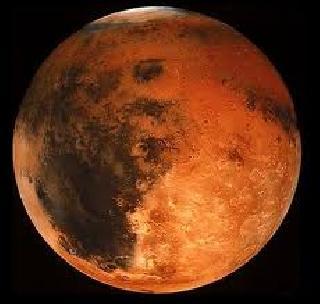
The ice cap on Mars' north pole is primarily composed of water ice and containing a few percent of dust. It has a spiral structure formed by white, ice-covered areas and dark slopes where the layers in the ice cap can be seen. A NASA/JPL photo
LONDON (PTI): Scientists have discovered that ice and dust may have accumulated on Mars's north pole driven by variations in solar insolation.
Researchers from the Niels Bohr Institute at the University of Copenhagen have established the first dated climate history for the Red Planet where ice and dust accumulation has happened due to variations in insolation.
The ice caps on Mars's poles are kilometres thick and composed of ice and dust. There are layers in the ice caps, which can be seen in cliffs and valley slopes and these layers have been known for decades, since the first satellite images came back from Mars.
The layers are believed to reflect past climate on Mars, in the same way that the Earth's climate history can be read by analysing ice cores from the ice caps on Greenland and Antarctica.
Solar insolation on Mars has varied dramatically over time, mainly due to large variations in the tilt of Mars's rotational axis (obliquity), and this led to dramatic climate variations on Mars.
For years scientists have tried to link the solar insolation and layer formation by looking for signs of periodic sequences in the visible layers, which can be seen in the upper 500 metres.
Periodic signals might be traceable back to known variations in the solar insolation on Mars, but so far it has been unclear whether one could find a correlation between variations in insolation and the layers.
"Here we have gone in a completely different direction. We have developed a model for how the layers are built up based on fundamental physical processes, and it demonstrates a correlation between ice and dust accumulation and solar insolation," researcher Christine Hvidberg, said.
The researchers established a framework for the model that could explain the layer formation so that it was consistent with the observations.
By comparing the layer distribution in the model with precise measurements of the layer structure from high-resolution satellite images of the ice cap on Mars's north pole, they have discovered that the model is able to reproduce the complex sequences in the layers.
"The model dates the upper 500 metres of the northern ice cap on Mars, equivalent to approximately 1 million years and an average accumulation rate of ice and dust of 0.55 mm per year. It links the individual layers to the maxima in solar insolation and thereby establishes a dated climate history of the north pole of Mars over 1 million years," Hvidberg said in a statement.
The results were published in the scientific journal Icarus.
 Previous Article
Previous Article Next Article
Next Article













The Indian Air Force, in its flight trials evaluation report submitted before the Defence Ministry l..
view articleAn insight into the Medium Multi-Role Combat Aircraft competition...
view articleSky enthusiasts can now spot the International Space Station (ISS) commanded by Indian-American astr..
view article